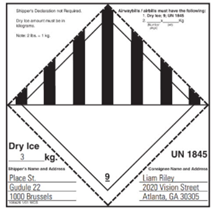 Back
Back
Shipping frozen goods safely with dry ice
10.07.2022 | by Maleen Scheible
If you want to ship frozen goods safely below -20 °C, there is no way around dry ice in combination with high-performance, passive insulating packaging. The practical thing about dry ice: unlike with cold packs, your customer has no waste since dry ice evaporates all by itself.
But beware: dry ice is considered a hazardous substance. Some precautions must be taken when sending dry ice by parcel service.
General information on the handling of dry ice
Dry ice is compressed, solid carbon dioxide (CO2) with a temperature of around -80 °C, which changes directly from the solid to gaseous state, thereby becoming volatile during shipping. Thus, dry ice should not be used as a cushioning material. The frozen goods should still be safely protected in the refrigerated packaging even when dry ice is almost completely sublimated.
It comes in the form of blocks, discs, nuggets, pellets and micropellets. For frozen shipping, nuggets, pellets and micropellets are mainly used. Blocks and discs are more suitable for very large packages and last longer due to their compact shape.
To avoid cold burns, dry ice should not be touched with bare hands. Use cold-insulating protective gloves and a scoop for dry ice pellets or nuggets.
The coolers should be filled with dry ice in well-ventilated rooms to avoid excessive inhalation of the carbon dioxide.
 Landpack insulated packaging – tried and tested for years by industry leaders in frozen food shipping – allows the carbon dioxide gas to escape. In this way, it prevents the package from bursting, which can happen with airtight sealed packages. The moisture regulation and breathability of natural fibres is an additional advantage in frozen shipping with dry ice.
Landpack insulated packaging – tried and tested for years by industry leaders in frozen food shipping – allows the carbon dioxide gas to escape. In this way, it prevents the package from bursting, which can happen with airtight sealed packages. The moisture regulation and breathability of natural fibres is an additional advantage in frozen shipping with dry ice.
Temperature profile of a cool box with dry ice
Your frozen goods are first cooled down significantly more in the cool box together with dry ice than in the freezer room. If you do not insulate the dry ice itself – like with our Dry Ice Boosters – the temperature in the cool box will start in a range from -50 to -60 °C. The temperature in the cool box will then be much lower than in the freezer.
As the surface of the dry ice continuously decreases, less and less cooling is released. While you can expect a loss of around 20% in the first 24 hours, 35% of the dry ice will have sublimated after about 48 hours. Especially at the end of the shipping period, the cooler is thus susceptible to excessive temperatures. Dry ice takes up a lot of space in the package and is also cost-intensive.
Our Landpack Dry Ice Boosters help while reducing your costs!
Fill up to 2 kg of dry ice into our environmentally friendly paper insulated bags. Your customers can easily dispose of our Dry Ice Boosters in the paper waste. This prevents unpleasant burns and avoid damage to the outer carton due to condensation.
Would you also like to save dry ice with our Dry Ice Booster? Get in touch with us!
Packing a cooler with dry ice
Packen Sie zuerst die Tiefkühlware in eine geeignete Isolierbox und füllen diese dann mit der benötigten Menge an Trockeneis auf. Wenn Trockeneis sublimiert, sinkt das Gas zu Boden, da es schwerer ist als Luft. Daher sollte Trockeneis tendenziell eher oben in der Kühlbox platziert sein, wobei ein Drehen des Paketes während dem Versand nicht ausgeschlossen werden kann. Entweder Sie geben das Trockeneis direkt in die Kühlbox oder Sie füllen es in unsere Dry Ice Booster, um eine Verbrennungsgefahr für Ihre Kunden zu vermeiden.
Für eine Simulation der benötigen Menge an Trockeneis in Abhängigkeit der Versandstrecke, Versanddauer und der aktuellen sowie prognostizierten Wetterlage hilft Ihnen unser Kühlmittelrechner.
Labelling packages with dry ice
When shipping dry ice domestically by road and rail, no generally applicable labelling of the package as dangerous goods transport is required. The individual parcel service providers regulate the labelling of the parcel individually with their own regulations.
For example, DHL only allows dry ice to be sent to business customers in express parcels. The parcels must be clearly labelled on the outside (e.g., carbon dioxide solid as coolant). UPS also only allows dry ice to be shipped to existing business customers. Dangerous goods documents must be enclosed with UPS for dry ice quantities of 2.2 kg/package or more.
Internationally, dry ice is deemed Class 9 Dangerous Goods with a M11 classification code (see UN No. 1845). When shipping internationally by air, a Class 9 Dangerous Goods label is mandatory (see IATA Dangerous Goods Regulations (DGR), www.iata.org/dangerousgoods). The sticker must show the quantity of dry ice contained and the address of both consignee and consignor.

Procurement and storage of dry ice
Ideally, you are supplied just-in-time by your dry ice supplier. This way you reduce the progressive sublimation of dry ice. With a temperature of just under -80 °C, freezer storage is also of little value. Make sure that the storage location is well ventilated.
This guide has been prepared to the best of our knowledge and belief. All information is non-binding. We expressly recommend that you observe the individual dangerous goods regulations of the respective courier and parcel service providers.
Categories
Tags
Author

Maleen Scheible
Trainee Vertrieb, Marketing & Operations

